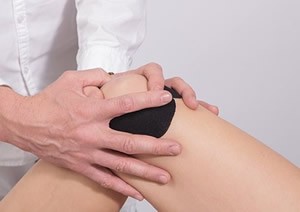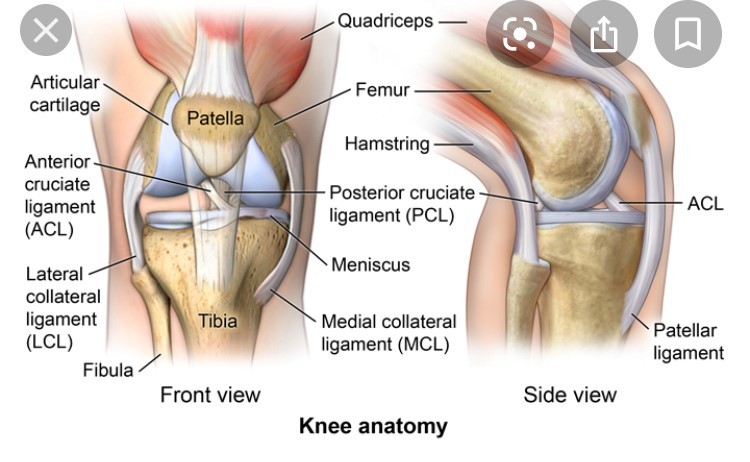 Hello and welcome to this week’s blog, all about knees. Whether you have regular issues with your knees, or you’ve never had a problem, it’s a good idea to be aware of how to take care of your knees so that you can continue to do the activities you love. This blog will give you a brief overview of some knee problems and what you can do to help yourself.
Hello and welcome to this week’s blog, all about knees. Whether you have regular issues with your knees, or you’ve never had a problem, it’s a good idea to be aware of how to take care of your knees so that you can continue to do the activities you love. This blog will give you a brief overview of some knee problems and what you can do to help yourself.
Some of the conditions that could affect you are listed below.
Patellofemoral Syndrome – also known as runner’s knee or jumper’s knee, characterised by discomfort, rubbing, grinding and/or clicking in your knee.
ACL/PCL Tear – Anterior Cruciate Ligament and Posterior Cruciate Ligament. These prevent the knee from sliding backwards or forwards and can be injured when impacted from the wrong direction.
MCL/LCL Tear – Medial Collateral Ligament and Lateral Collateral Ligament. These prevent the knee from sliding off to the side and similarly are injured during an impact from the wrong direction.
Meniscus Issue – this is cartilage that cushions the impact between the femur and tibia, and there are two in each knee joint.
ITB Syndrome – Iliotibial Band Syndrome is when this large fascia is hypertonic (tight) and causes pressure on its attachments.
Tendonitis – irritation to the patella tendon or other tendon nearby.
Fracture – a break to the femur at the knee, the tibia at the knee or the patella.
Arthritis – joint discomfort, stiffness, tenderness, inflammation, weakness.
Sprain/Strain – injured muscle, tendons or ligaments which takes time to heal.
Bakers Cyst – a fluid filled cyst behind your knee.
Maltracking Patella – the kneecap can be pushed out of position during an accident or injury and not sit quite right properly afterwards. It can also be pulled out of position by a hypertonic muscle.
Dislocation – where the tibia, fibular or patella become dislocated from its correct position, usually by force.
Bursitis – an irritation to one of the bursae in and around the knee.
Chrondomalacia – another name for runner’s knee. Where the cartilage on the underside of the patella deteriorates and softens.
Gout – causes tenderness and swelling, along with redness, warmth and stiffness.
Osgood-Schlatter’s – a condition mostly effecting adolescents. Whereby the patella ligament is irritated and becomes inflamed by the tibial tuberosity, the hard bump beneath your knee, where the tendon attaches.
Genu Valgum – otherwise known as ‘knock knees’. This is when the knees are close together and the feet are far apart, caused by rickets, obesity or injury.
Genu Varum – known as ‘bow legs’. Where the knees are far apart while the feet are together. A genetic bone shape that can occasionally be corrected with surgery.
The above is just a handful of potential issues with your knees. As with anything, a diagnosis is the first step to understanding what is happening within your knee. Then how to go about managing and recovering from it.
Anatomy of Your Knee
The next step to understanding your knee issue is to know the anatomy of your knee. Below is a picture of the inside of your knee. You will see some of the areas mentioned in my list above.
Your knee is the midpoint of your leg. Where the femur bone meets the tibia and where there is a small ‘floating’ bone, called the patella. You will know it as your knee cap. Without this bone, bending your knee would be ineffective and it would hurt. Look at the side view on the right-hand side of the picture and see if you can see why that would be… interesting, isn’t it? The fibula is also attached to the knee joint via the Lateral Collateral Ligament (LCL).
Your knee is often considered to be the weak point of the body. But that’s no reason to just expect injuries or issues here, and there are many things you can do to help avoid future problems.
Muscles of your Knees
There are thirteen muscles involved in healthy knee movement. The main culprits are the quadriceps group, the hamstrings group, the adductor group and the gastrocnemius and soleus. Some smaller, but very important muscles to remember are the plantaris, which aids knee flexion and the popliteus, which is known as the ‘key muscle’ as it helps unlock the knee from the straightened position, vital for walking and running.
Hypertonicity or weakness in any of these muscles could lead to issues with your knee, and more importantly, there could be an issue in your lower back or hips which refers to the knee, and this is because of the very close relationship the knee muscles have with the pelvis and lower back.
Self-Help Knee Issues
The first thing to remember about your knees, is to respect them. Cushion them when kneeling for prolonged periods of time, allow them to recover adequately between running and jumping activities as well as ensuring you do enough strengthening work to keep them strong, especially if you perform twisting movements during your sport.
Remember that other than accidents and injuries, most knee issues arise from overuse or poor use. This happens when your knee, or any of its supporting structures, is too weak for the activity you are doing. Please do ease yourself into anything new, or if you wish to increase the load of your activity, to do so incrementally.
Sports Massage is a very quick way to find out what could be bothering you, as well as providing you with the right advice as to what exercises you should be performing to aid recovery. Massage can also increase blood flow to your muscles, tendons and ligaments, which allows for healing to take place.
Resting when necessary will also speed recovery
Resting when necessary will also speed recovery, because despite a lot of people believing this, ‘pushing through’ is rarely a good or efficient way to heal.
Strengthening exercises are vital to all over muscular and joint health, and it’s no different for the knee. Look at strengthening your quads, hams and adductors as well as your calves, as these will help stabilise your knee.
Resistance bands are an excellent piece of equipment to have at home to help strengthen the knee joint, usually by placing a directional pressure upon it while you repetitively perform the exercise. Seek professional advice for the exact exercises you should do for your issue.
Swimming is a good all rounder exercise should you wish to take the pressure off your knees, as well as cycling, if you’re able.
Please do get in touch if you need specific advice, I do have online consultations available and hope to back to massage appointments in early July.
See you on the other side,
Chloe

